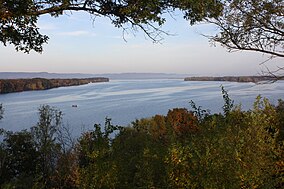Upper Mississippi River National Wildlife and Fish Refuge
| Upper Mississippi River National Wildlife and Fish Refuge | |
|---|---|
IUCN category IV (habitat/species management area) | |
 Looking west over the Mississippi River from an overlook within the Upper Mississippi River National Wildlife and Fish Refuge | |
 Map of the United States | |
| Location | Illinois, Iowa, Minnesota, Wisconsin, United States |
| Nearest city | Dubuque, Iowa |
| Coordinates | 42°53′00″N 91°06′00″W / 42.88333°N 91.10000°WCoordinates: 42°53′00″N 91°06′00″W / 42.88333°N 91.10000°W |
| Area | 240,000 acres (970 km2) |
| Established | 1924 |
| Governing body | U.S. Fish and Wildlife Service |
| Website | Upper Mississippi River National Wildlife and Fish Refuge |
Ramsar Wetland | |
| Official name | Upper Mississippi River Floodplain Wetlands |
| Designated | 1 May 2010 |
| Reference no. | 1901[1] |
The Upper Mississippi River National Wildlife and Fish Refuge is a 240,000-acre (970 km2),[2] 261-mile long (420 km) National Wildlife Refuge located in and along the Upper Mississippi River. It runs from Wabasha, Minnesota in the north to Rock Island, Illinois in the south.

In its northern portion, it is in the Driftless Area, a region of North America that remained free from ice during the last ice age. Certain parcels contained within the refuge were later transferred to the Driftless Area National Wildlife Refuge.
The refuge is an important element of the Mississippi Flyway. It has many wooded islands, sloughs, and hardwood forests. The wildlife found here include the canvasback duck, tundra swan, white-tailed deer, and muskrat. Recreational activities include boating, hunting, fishing, and swimming.
Refuge Headquarters are located in Winona, Minnesota, with district offices located in La Crosse, Wisconsin, Prairie du Chien, Wisconsin, and Thomson, Illinois.
Geography[]
The refuge is one of only two that spans portions of four states (the other is Silvio O. Conte National Fish and Wildlife Refuge). As of 30 September 2007 the area per state was: Wisconsin: 89,637.54 acres (362.75 km2), Iowa: 51,147.78 acres (206.99 km2), Minnesota: 33,868.64 acres (137.06 km2), Illinois: 33,489.57 acres (135.53 km2).[3]
The following counties border on or have land within the Upper Mississippi River National Wildlife and Fish Refuge. In each state, the counties are listed from north to south. The lakes and rivers within the refuge area of each county are also listed.
Minnesota[]
- Wabasha County
- Cross Lake
- Half Moon Lake
- Maloney Lake
- McCarthy Lake
- Peterson Lake
- Robinson Lake
- Zumbro River
- Winona County
- Houston County
- Blue Lake
- Hayshore Lake
- Lawrence Lake
- Root River
- Target Lake
Wisconsin[]


- Buffalo County
- Trempealeau County
- La Crosse County
- Vernon County
- Crawford County
- Grant County
Iowa[]
- Allamakee County
- Clayton County
- Dubuque County
- Jackson County
- Clinton County
- Scott County
Illinois[]
- Jo Daviess County
- Carroll County
- Whiteside County
- Rock Island County
See also[]
- Izaak Walton League
- List of National Wildlife Refuges
- Trempealeau National Wildlife Refuge
- Upper Mississippi River Locks and Dams
References[]
- ^ "Upper Mississippi River Floodplain Wetlands". Ramsar Sites Information Service. Retrieved 25 April 2018.
- ^ Upper Mississippi River National Wildlife & Fish Refuge, Retrieved July 15, 2007
- ^ U.S. Fish and Wildlife Service. "National Wildlife Refuge System".
![]() This article incorporates public domain material from websites or documents of the United States Fish and Wildlife Service.
This article incorporates public domain material from websites or documents of the United States Fish and Wildlife Service.
External links[]
| Wikimedia Commons has media related to Upper Mississippi River National Wildlife and Fish Refuge. |
- IUCN Category IV
- Protected areas of Allamakee County, Iowa
- Protected areas of Clayton County, Iowa
- Protected areas of Clinton County, Iowa
- Protected areas of Dubuque County, Iowa
- Driftless Area
- Protected areas of Houston County, Minnesota
- Protected areas of Jackson County, Iowa
- National Wildlife Refuges in Illinois
- National Wildlife Refuges in Iowa
- National Wildlife Refuges in Minnesota
- National Wildlife Refuges in Wisconsin
- Protected areas on the Mississippi River
- Protected areas established in 1924
- Protected areas of Buffalo County, Wisconsin
- Protected areas of Carroll County, Illinois
- Protected areas of Crawford County, Wisconsin
- Protected areas of Grant County, Wisconsin
- Protected areas of Jo Daviess County, Illinois
- Protected areas of La Crosse County, Wisconsin
- Protected areas of Rock Island County, Illinois
- Protected areas of Trempealeau County, Wisconsin
- Protected areas of Vernon County, Wisconsin
- Protected areas of Whiteside County, Illinois
- Protected areas of Scott County, Iowa
- Protected areas of Winona County, Minnesota
- Protected areas of Wabasha County, Minnesota
- Ramsar sites in the United States
- Wetlands of Illinois
- Wetlands of Iowa
- Wetlands of Wisconsin
- Wetlands of Minnesota
- Landforms of Allamakee County, Iowa
- Landforms of Clayton County, Iowa
- Landforms of Clinton County, Iowa
- Landforms of Dubuque County, Iowa
- Landforms of Houston County, Minnesota
- Landforms of Jackson County, Iowa
- Landforms of Buffalo County, Wisconsin
- Landforms of Carroll County, Illinois
- Landforms of Crawford County, Wisconsin
- Landforms of Grant County, Wisconsin
- Landforms of Jo Daviess County, Illinois
- Landforms of La Crosse County, Wisconsin
- Landforms of Rock Island County, Illinois
- Landforms of Trempealeau County, Wisconsin
- Landforms of Vernon County, Wisconsin
- Landforms of Whiteside County, Illinois
- Landforms of Scott County, Iowa
- Landforms of Winona County, Minnesota
- Landforms of Wabasha County, Minnesota
- 1924 establishments in Wisconsin
- 1924 establishments in Minnesota
- 1924 establishments in Illinois
- 1924 establishments in Iowa
